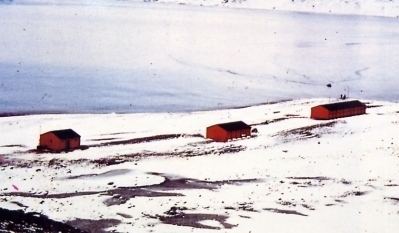Time zone AST (UTC-04:00) | ||
 | ||
The Machu Picchu Scientific Base is a Peruvian polar scientific research facility in Antarctica, established to conduct Antarctic research on geology, climatology and biology. More specifically, its purpose is to study the continent's geological past, potential sea resources, wind strengths, air pollution, and the animal adaptation in a freezing environment. The base is named after the World Heritage site Machu Picchu.
Contents
- Map of Machu Picchu Base Antarctica
- Geography
- Research base and expeditions
- Peruvian claim
- Regulatory authorities
- References
Map of Machu Picchu Base, Antarctica
Geography
Being located at 62°S, Machu Picchu Base is one of the northernmost settlements in Antarctica. It, along with Artigas Base, Carlini Base and Villa Las Estrellas forms the only human settlements on the island.
Research base and expeditions
Peru maintains Machu Picchu Base, a scientific research installation on King George Island in Admiralty Bay, and conducts annual scientific expeditions to Antarctica. The base carries out a variety of scientific projects such as research into krill and its potential as an alternative human food source, as well as geological, biological, hydrographic, and geophysical research, under the provisions of the Antarctic Treaty. The base operates radar measuring the winds in the upper atmosphere, supplying data on the deteriorization of the ozone layer.
As Antarctica is a continent of valuable strategic, ecological, and economic importance, Peru has an interest in maintaining its status as a non-militarized, nuclear-free zone of peace, and in preserving its environment, which is important to the Peruvian climate. Its frigid waters, the origin of the Humboldt Current, are essential to Peru's marine and coastal ecosystems.
Since 1988, maintenance, supply, and transport of personnel for the base have been performed by the Instituto del Mar de Perú's scientific research vessel B.I.C. Humboldt.
Peruvian claim
In 1976 the Geographical Society of Lima claimed rights to a sector of Antarctica between the meridians 81°20' W (corresponding to Punta Pariñas) and 75°40' W (corresponding to Rinconada South Beach). This initiative led to a declaration by the Peruvian Constitutional Assembly on 3 May 1979:
However, the claim is not officially recognized as one of the Territorial claims in Antarctica.
In 1981 the director of Instituto Peruano de Estudios Antárticos, Luis Vilchez Lara, made a press statement expressing its view that Peru is entitled to an Antarctic sector 600.000 km2 between the meridians 84° y 90° West and to the South Pole. Vilchez Lara based its opinion based on the theory of plural condo of Fauchille, and the application of the principle of uti possidetis.
On 10 April 1981, Peru joined the Antarctic Treaty as a member adherent, with voice and vote in making all decisions related to the southern area. However, in agreeing to the Treaty, Peru reserved its rights to territory and influence over Antarctic climate, ecology and marine biology, in addition to a continuity of geology and historical links. In 1989, when Machu Picchu Base was founded, it acquired the status of advisory member within the Antarctic Treaty.
In 1993 the Constituent Assembly extended the declaration of 1979:
Regulatory authorities
The Peruvian government created a National Commission for Antarctic Affairs (CONAAN) in July 1983 as a technical body composed of various agencies. It was charged with:
On 20 November 2002 CONAAN was reconstituted as the Peruvian Antarctic Institute (INANPE), a decentralized agency incorporated under domestic law and having scientific, technical, functional, economic, and administrative autonomy, organized under the Ministry of Foreign Affairs. It had the same tasks as CONAAN, and on top coordinates all Peruvian activities in the Antarctic.
